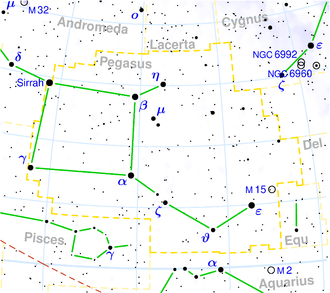NGC 7766
| Galaxie NGC 7766 | |
|---|---|
![NGC 7768, LEDA 1798869 (o), NGC 7766 (m), LEDA 1797966[1] (u)](http://upload.wikimedia.org/wikipedia/commons/thumb/9/98/NGC7766_-_SDSS_DR14.jpg/300px-NGC7766_-_SDSS_DR14.jpg) | |
| NGC 7768, LEDA 1798869 (o), NGC 7766 (m), LEDA 1797966[1] (u) | |
| AladinLite | |
| Sternbild | Pegasus |
| Position Äquinoktium: J2000.0, Epoche: J2000.0 | |
| Rektaszension | 23h 50m 55,9s[2] |
| Deklination | +27° 07′ 35″[2] |
| Erscheinungsbild | |
| Morphologischer Typ | C[2][3] |
| Helligkeit (visuell) | 15,5 mag[3] |
| Helligkeit (B-Band) | 16,5 mag[3] |
| Winkelausdehnung | 0,5' × 0,2'[3] |
| Positionswinkel | 43°[3] |
| Flächenhelligkeit | 12,9 mag/arcmin²[3] |
| Physikalische Daten | |
| Rotverschiebung | 0.027159 ± 0.000173[2] |
| Radialgeschwindigkeit | 8142 ± 52 km/s[2] |
| Hubbledistanz vrad / H0 | (372 ± 26) · 106 Lj (114,0 ± 8,0) Mpc [2] |
| Geschichte | |
| Entdeckung | Ralph Copeland |
| Entdeckungsdatum | 9. Oktober 1872 |
| Katalogbezeichnungen | |
| NGC 7766 • PGC 72611 • CGCG 477-018 • MCG +04-56-017 • 2MASX J23505589+2707347 • GALEXASC J235055.89+270736.7 • HOLM 818D | |
NGC 7766 ist eine kompakte Galaxie vom Hubble-Typ C im Sternbild Pegasus am Nordsternhimmel. Sie ist schätzungsweise 372 Millionen Lichtjahre von der Milchstraße entfernt und hat einen Durchmesser von etwa 55.000 Lichtjahren. Gemeinsam mit NGC 7765, NGC 7767 und NGC 7768 bildet sie die Galaxiengruppe Holm 818.
Das Objekt wurde am 9. Oktober 1872 von Ralph Copeland entdeckt.[4]
Weblinks
Einzelnachweise
Auf dieser Seite verwendete Medien
Autor/Urheber: Sloan Digital Sky Survey, Lizenz: CC BY 4.0
The sky image is obtained by Sloan Digital Sky Survey, DR14 with SciServer.
Angle of view: 4' × 4' (0.3" per pixel), north is up.
Details on the image processing pipeline: https://www.sdss.org/dr14/imaging/jpg-images-on-skyserver/



